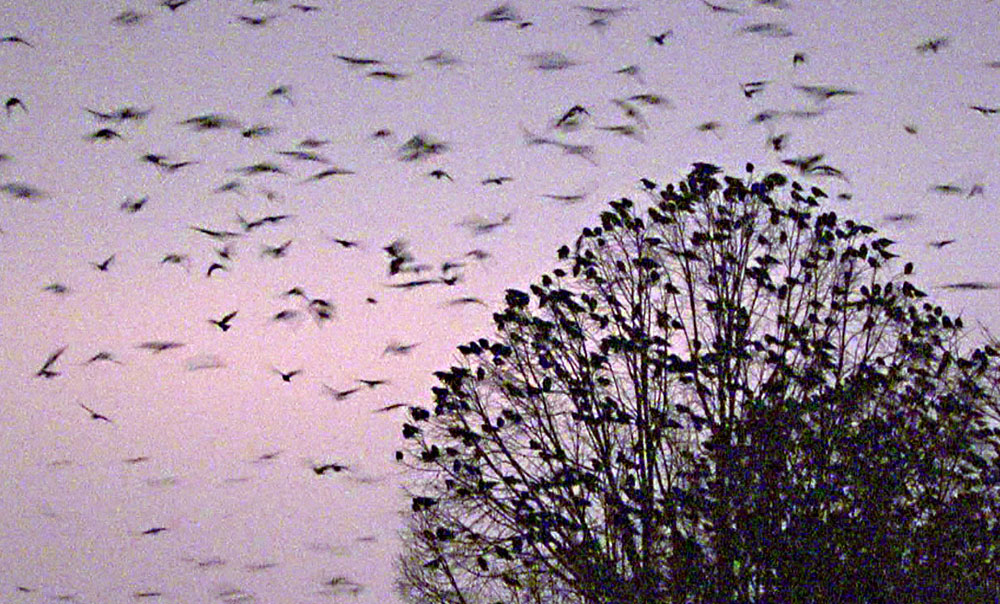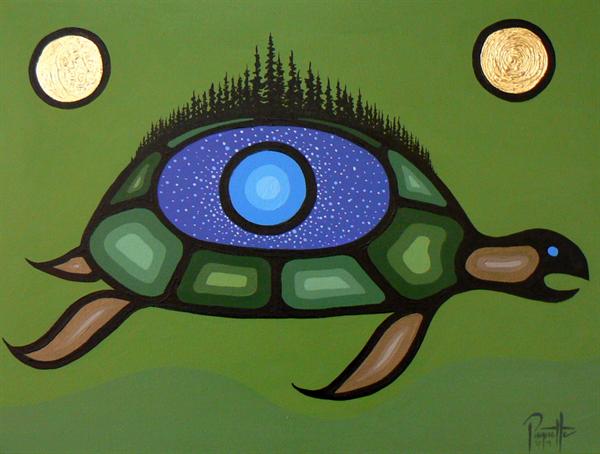“Have you ever seen how all the crows congregate in Burnaby every evening around dusk?” my partner asked me one night. “It’s a bit sinister, but pretty majestic to see all these black shapes gathering towards the same spot.”
“It’s an old game,” I told her, “one that the crows have been playing since the beginning of imagination.”
“Is that so?” Indulgent as always, and recognising the twinkle in my eyes and the tone of my voice, she put down her teacup and settled her head into my lap to listen to the story.
“The crows have been doing that for as long as anyone can remember. Long before Burnaby was Burnaby and when it was simply impenetrable forest and mountain and wildness. Have you noticed the way they look at you as they perch on telephone wires and the sides of roads? They remember the loss of the forests, and they’re still suspicious of concrete and metal and the electrical wires that strangle the air.”
My partner, who does not have much patience for anthropomorphism, raised an eyebrow.
“You can tell by their voices,” I insisted, “they used to have voices like silk and honey.”
“What happened?”
“The trouble started with the stories.”
“What?”
“Let me back up. As I mentioned, the crows have been meeting in that spot every day for centuries. The very first time they met there, back before wind moved across the world, it was for a kind of game, a competition to see who could come up with a way to capture all the forces of imagination. That’s what magic is made of, and they wanted to harness it so they had all that power at their disposal.
They still meet there, trying to catch hold of the forces of imagination, hoping to work some magic to return some wildness to the corners of the world that need it most. But, I digress.
“The first time they did this,” I continued, “the crows did all kinds of curious magical things. They turned themselves inside out, they threw off all of their feathers and paraded around naked, they worked together to create huge formations in the sky, they sang songs with their honey voices, and they brought shiny things from the farthest reaches of the world to create giant glittering sculptures. This conference went on for days and days. Finally, after all the other crows had done their bit, they realised that there was still one crow who had not spoken.
‘What about you?’ they asked, peering at the last crow intently, ‘don’t you have anything to contribute? Don’t you have any tricks for capturing imagination?’
And then the last crow opened her mouth and told a story.”
“That’s it?” my listener asked, “all that hype for just a story?”
“Not just any story – the most thrilling story you’ve ever heard. It twisted and turned, stretched to the farthest limits of understanding and swooped back around in a way that made all the other crows second-guess the beaks on their faces.
By the time the crow had finished telling her story, the others were silent for the first time in days.
They decided unanimously that she had won the competition. No sooner had they said so, that they felt a shimmering in the air, a kind of rushing and whistling.”
“The wind?”
“Ah, so you were paying attention.”
“I always pay attention!”
“Yes, of course. This all happened, as I said before, in the time before the wind. And now, all of a sudden, a breeze sprang up, and started to ruffle the birds’ glossy feathers.
‘That’s it,’ they said, ‘you win. But maybe now you could take it back? We’re not sure we like what you’ve unleashed, we don’t know what —‘
But their words were snatched away by the wind. Some of the crows lifted themselves up into the sky, but they were buffeted by the air that had, until that point, always been calm and still.
They shouted and cried through the shifting currents of air, begging the last crow to take her story back, to get rid of all this wind. They shouted so much that their voices became hoarse and raspy, and lost forever their silk and honey tones.”
“But what about the story? Did the crow undo what she had done and make the wind calm down?” my partner wanted to know.
“Of course not. Don’t you know? Once a story is loose in the world, it cannot be taken back. It’s there for good.
And that’s how the wind was born.”
Crows are one of my favourite subjects: they are tricksters and magic-makers, and just unpredictable enough to keep you guessing. I am a storyteller at heart, and this kind of creative work is just what I like to do. There’s something special about weaving a story as you tell it – I like to leave a little bit up to improvisation, and let my words be affected by the reception I get from my audience. That way, the story changes a little with each telling, shifting to suit a particular audience, while still retaining its essence.
The interesting thing, though, is to take a story that has only ever been heard aloud and change it into a written form. I tried my best not to let the story alter when I wrote it down, but inevitably it did. There’s no way to account for the multi-dimensional quality of oral storytelling – tone, body language, gesture, and expression – so the words themselves must take on a new responsibility when they are written. It feels strange to let these words go out into the world without being able to control the way they are received – ultimately, it’s up to the reader to shape the way they sound in their head.
I’ve been hooked on King’s writing ever since I read The Inconvenient Indian and a few other works. The Truth About Stories was no different. One of the marvellous thing about King’s work is his conversational style; it feels like you’re really in the room with him. Somehow he manages to convey a certain level of eye-twinkling and sardonic humour that is rarely found in written text.
I couldn’t stop reading the book at the end of the first chapter – King’s words are simply too delicious to part with, and it felt disingenuous to put it down when we were in the middle of a conversation.
Works Cited:
Donaldson, Emily. “The Inconvenient Indian: A Curious Account Of Native People In North America.” Quill & Quire. n.d. Web. 29 May 2014.
King, Thomas. “The Truth About Stories: A Native Narrative” Toronto: House of Anansi P., 2003. Print.
Lazaruk, Susan. “Murder Mystery: The Reason Why 6,000 Crows Flock To Burnaby Every Night.” The Province. (Vancouver) 30 Oct, 2013. Web. 28 May 2014.


